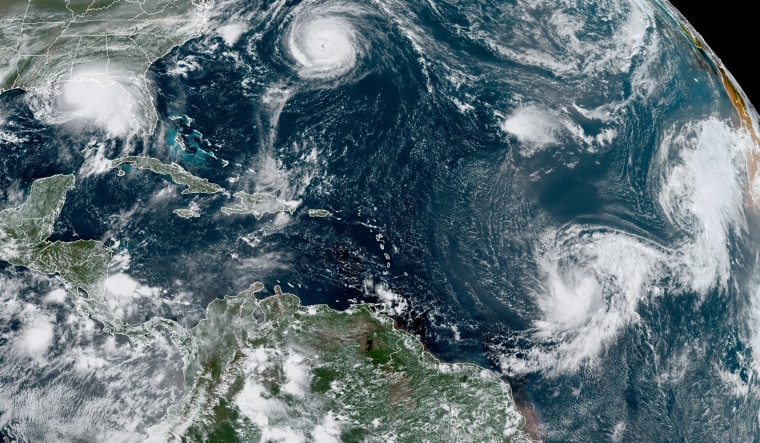It's alive.
A week after Hurricane Paulette hit Bermuda and weakened as it spun north in the Atlantic Ocean, the system has come back to life as a "zombie" tropical storm, according to the National Oceanic and Atmospheric Administration.
NOAA's National Hurricane Center issued an advisory late Monday saying Tropical Storm Paulette had re-formed southeast of the Azores, a series of islands off the coast of Portugal. At the time, the storm had maximum sustained winds of 60 mph.
It's not the first time that NOAA has observed a storm coming back to life, but experts said it's still an unusual phenomenon — one that comes during an extremely busy hurricane season in a year that has been chock full of extremes.
"It's not unprecedented, but it's not something we see very often, and it kind of fits this year of weird, weird things happening," said Phil Klotzbach, an atmospheric scientist at Colorado State University in Fort Collins.
The National Weather Service also referred to the odd nature of the storm's return, tweeting Tuesday: "Because 2020, we now have Zombie Tropical Storms. Welcome back to the land of the living, Tropical Storm #Paulette."
Paulette originally formed in early September and made landfall in Bermuda on Sept. 14 as a Category 1 hurricane. The storm strengthened to Category 2 as it passed over the island, but it eventually moved northeast into open waters and was downgraded to a "post-tropical cyclone" on Sept. 16. This classification is used to describe storms systems that no longer have the characteristics that define a tropical cyclone.
Storms that migrate into the northern Atlantic Ocean normally fizzle out as they hit colder water, said Jeff Weber, a meteorologist at the University Corporation for Atmospheric Research, a nonprofit consortium of more than 100 universities and colleges in Boulder, Colorado. In this case, however, Paulette bumped into a high-pressure trough in the mid-Atlantic that pushed the storm south, where it encountered warm water that enabled it to re-form as a tropical storm.
"For this system to dive that far south and regain its tropical characteristics — that's the unusual aspect here," Weber said.
Scientists have recorded other instances of hurricanes that have re-formed as zombie tropical storms, Klotzbach said. The most recent example is Ivan, which plowed through the Caribbean and made landfall as a Category 3 hurricane near Gulf Shores, Alabama, in September 2004. The storm weakened as it moved into the subtropical Atlantic but respawned as a tropical cyclone and hit the Southeastern United States again later that month.
"If you go back in the historical record, there have been storms that have done some weird things," Klotzbach said. "Certainly Paulette joins that list now."
Although climate change is making hurricanes more intense and therefore more destructive, Klotzbach said, global warming is not likely to be squarely to blame for the return of Paulette.
But it's possible that oceans warming because of climate change could make zombie storms more common in the future, Weber said, because warmer oceans "will be able to support tropical development over larger areas of the Atlantic."
But for all the drama of Paulette's rebirth, the storm's second life isn't expected to last very long. The system had already weakened as of Tuesday morning, with maximum sustained winds of 40 mph, and it is projected to degrade further.
"Additional weakening is forecast to take place, and Paulette is expected to become a remnant low within the next day or so," Dennis Feltgen, a meteorologist and spokesperson for the National Hurricane Center, said in an email.

